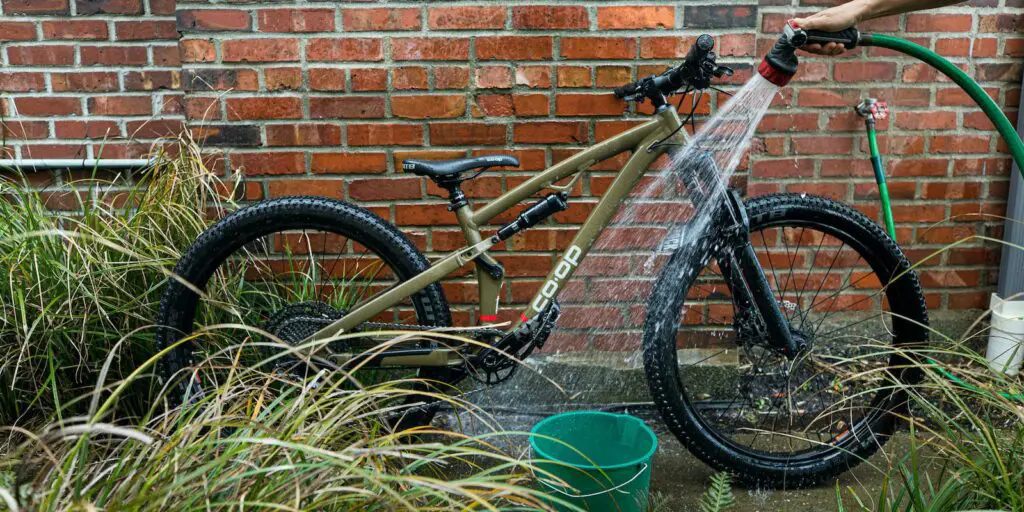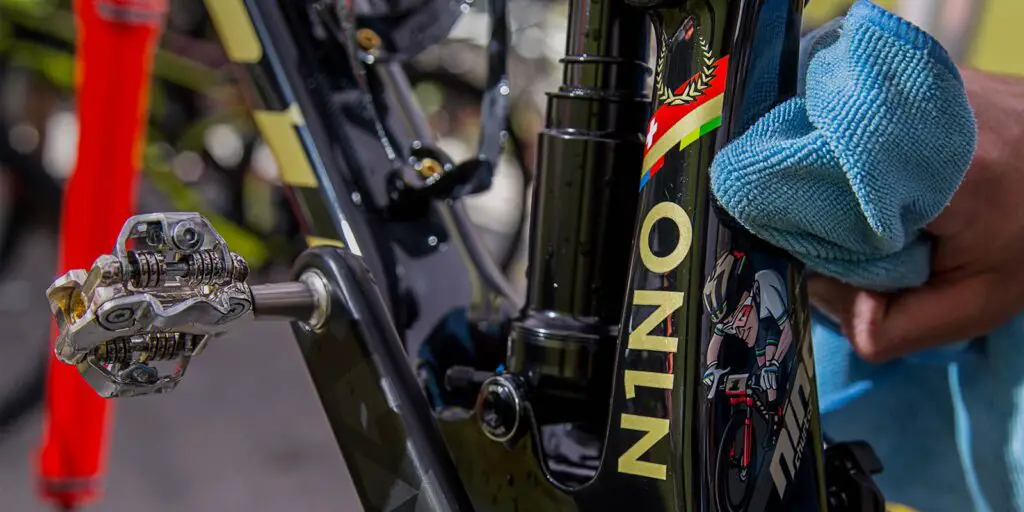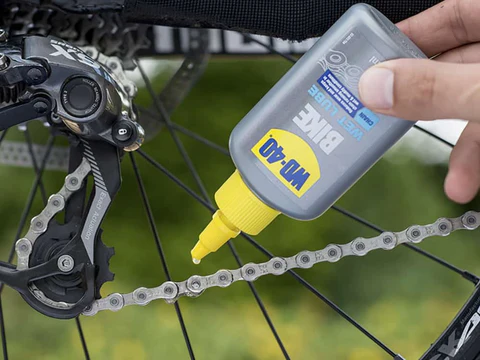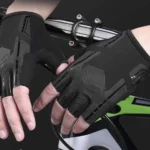
Riding through muddy trails on a mountain bike is an exhilarating experience. The scenery is picturesque, and the feeling of speed is exhilarating. However, after the ride is over, it’s essential to take care of your bike. Keeping your bike clean will help to maintain its condition.
When should you clean your bike? Clean your bike after every muddy ride or every couple of weeks in dry climates. It’s best to wash your bike immediately after you get home, even before you take a shower.
But how do you clean your muddy bike? In this article, we will provide a quick guide on how to clean your muddy bike in five simple steps. First, rinse off the mud with a hose. Second, use a brush to scrub off any remaining dirt. Third, use a cleaning solution and a cloth to clean the frame and components. Fourth, rinse off the cleaning solution and dry the bike. Lastly, lubricate the moving parts.

By following these simple steps, you will ensure that your mountain bike stays in excellent condition for your next adventure. Remember, regular cleaning is essential for maintaining your bike’s performance and longevity.
Table of Contents
Is it okay to not clean mud off my bike?

It’s essential to clean your bike after a muddy ride, not only for aesthetic reasons but also to protect your bike’s components. If you leave gunk and mud on the drivetrain, it can lead to potential corrosion and rust build-up. This can cause your cassette, chain, and chain rings to wear out faster, and you might need to replace them more often than necessary.
Cleaning should be a significant part of your mountain bike maintenance routine. Washing your bike and lubricating often helps extend bike parts and give your bike a long, happy life. When cleaning your bike, focus on removing the mud, cleaning all parts, and lubricating your mountain bike to maintain good performance.
It’s also important not to over-clean or over-lubricate. Over lubricating leads to component damage and poor performance. Excess lube ends up attracting extra dirt and other abrasive materials. To avoid this, wipe off the excess lube carefully before riding the bike again.
Regular cleaning and maintenance are essential for keeping your mountain bike in top condition. By taking care of your bike, you’ll ensure that it’s ready for your next adventure.
Is it necessary to clean my bike after each ride?
It’s essential to consider when to clean your mountain bike and how often it is necessary. Cleaning your bike is necessary to prolong its life and improve performance. With the market for mountain bikes on the rise, and projected to hit $78.5 million units in 2027, you want to make sure you are maintaining your bike to prolong its lifespan and avoid costly repairs or replacements.
It’s important to note that mountain bikes don’t need to be cleaned every day. The amount of mud on your bike will determine whether cleaning is necessary or not. Jumping over a few puddles of clean water or a few specks of dirt on the tube doesn’t necessarily mean you need to get your brushes out.
Bikes are meant to be ridden and get dirty in the process, but that doesn’t mean cleaning them after every ride. Once you get home, inspect your bike and determine whether cleaning is necessary or not. Sometimes, you may run into clean water puddles that end up washing the bike clean by the time you get home. In general, it’s a good idea to clean your bike after every muddy ride or every couple of weeks in dry climates. This will ensure that your bike stays in good condition for your next adventure.
Is it safe to clean my mountain bike by spraying it with water?

Yes, using a hose to clean your bike is appropriate, but it’s important to be careful when doing so. High-pressure jet washers, like those used at car washes and industrial sprayers, should be avoided when cleaning your bike. The high-pressure nozzle can blow the bearing seals inward, which can cause damage to the bike. Additionally, if you point the nozzle at the bike from the side, it can force debris and other materials into sensitive areas such as headsets, hubs, and bottom brackets.
Additionally, using high pressure can wash off the grease that is designed to prevent water and dirt from entering the bearings. The grease is essential for protecting the bearings and keeping them running smoothly. It’s best to use a low-pressure nozzle when cleaning your bike to avoid any damage.
What is the proper way to clean a muddy mountain bike?

Cleaning your mountain bike after a muddy ride doesn’t have to feel like a punishment. Many people find it demotivating, and that’s why they end up abandoning their bikes in the shed and riding less. But, it’s important to remember that regular cleaning is essential for maintaining your bike’s performance and longevity.
If you’re someone who likes to ride your bike every day, a quick wash can help get your bike in excellent condition in no time. Here are a few quick cleaning tips to help you get the job done faster:
1. Locate a spot to wash it
Cleaning your mountain bike after a muddy ride is essential for maintaining its performance and longevity. If you’re unable to ride home due to mud build-up, there are a few options available to help clean your bike.
- Purpose-built mountain biking trail systems often include a bike washstand along the trailhead. Look for a washstand on your trail and wash your bike.
- Head to your local bike shop. Many bike shops have washstands where you can clean your bike.
- Find a place with plenty of water, like a river or creek, and prepare to clean your mountain bike. Make sure to use a low-pressure nozzle and avoid using high-pressure jet washers to avoid damage to your bike.
2. Get Cleaning Materials
It’s always a good idea to have a brush or two on hand when heading out to ride on a muddy trail. A brush can help you clean your bike faster and more efficiently. If you’re cleaning your bike at home, make sure to have your hose and other cleaning materials ready. This will make the cleaning process go more smoothly and save you time.
3. Proceed to clean your mountain bike
You can use soap to help clean the bike, but it’s not mandatory. The key is to make sure that the bike is thoroughly scrubbed to remove as much mud as possible. Use the larger brush to clean the frame and wheels, and then use the smaller brush to reach tight spaces and crevices.
Make sure to focus on the drivetrain and other moving parts, as these are the areas that are most likely to collect dirt and grime. Clean them thoroughly to ensure smooth performance and to prolong the life of the components.
4. Proceed with drying your mountain bike

Use a cloth or a rag to remove as much water as possible, particularly from the chain components and other moving parts. This will help to prevent rust and other forms of corrosion from developing.
5. Lubricate
When your bike is dry, it’s time to do a complete lubrication job. First, lubricate the chain. Then, move on to other moving parts such as the derailleurs. After a few minutes, wipe off any excess lubricant.
That’s all there is to it! The process is simple and quick. Now, go out and enjoy your bike again. Don’t forget that regular cleaning will help prolong the life of your bike.
Related Q&A
How often should I wash my mountain bike?
It’s recommended to wash your bike after every ride, especially if it’s been ridden in muddy or dirty conditions.
What do I need to wash my mountain bike?
You’ll need a bucket, bike wash solution, a brush with soft bristles, a rag or sponge, and a hose or pressure washer.
Can I use dish soap to wash my mountain bike?
It’s not recommended to use dish soap as it can strip the lubricants off the bike’s moving parts. It’s best to use a bike-specific wash solution.
Should I lubricate my bike before or after washing it?
It’s best to lubricate your bike after washing it and allowing it to dry completely.
Can I use a power washer to clean my mountain bike?
Yes, you can use a pressure washer to clean your bike, but be careful not to use too much pressure and avoid pointing it directly at the bearings and seals.
How do I dry my bike after washing it?
After washing your bike, use a clean rag or sponge to wipe it down and remove excess water. Allow the bike to air dry or use a chamois to remove any remaining moisture.
Read Also: How to Install Bicycle Computer and GPS










One reply on “Should You Wash Your Mountain Bike When it Gets Muddy?”
[…] Read Also: Should You Wash Your Mountain Bike When it Gets Muddy? […]